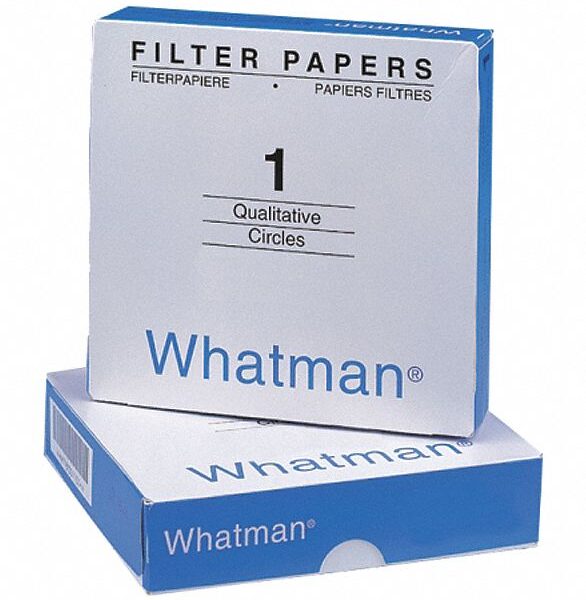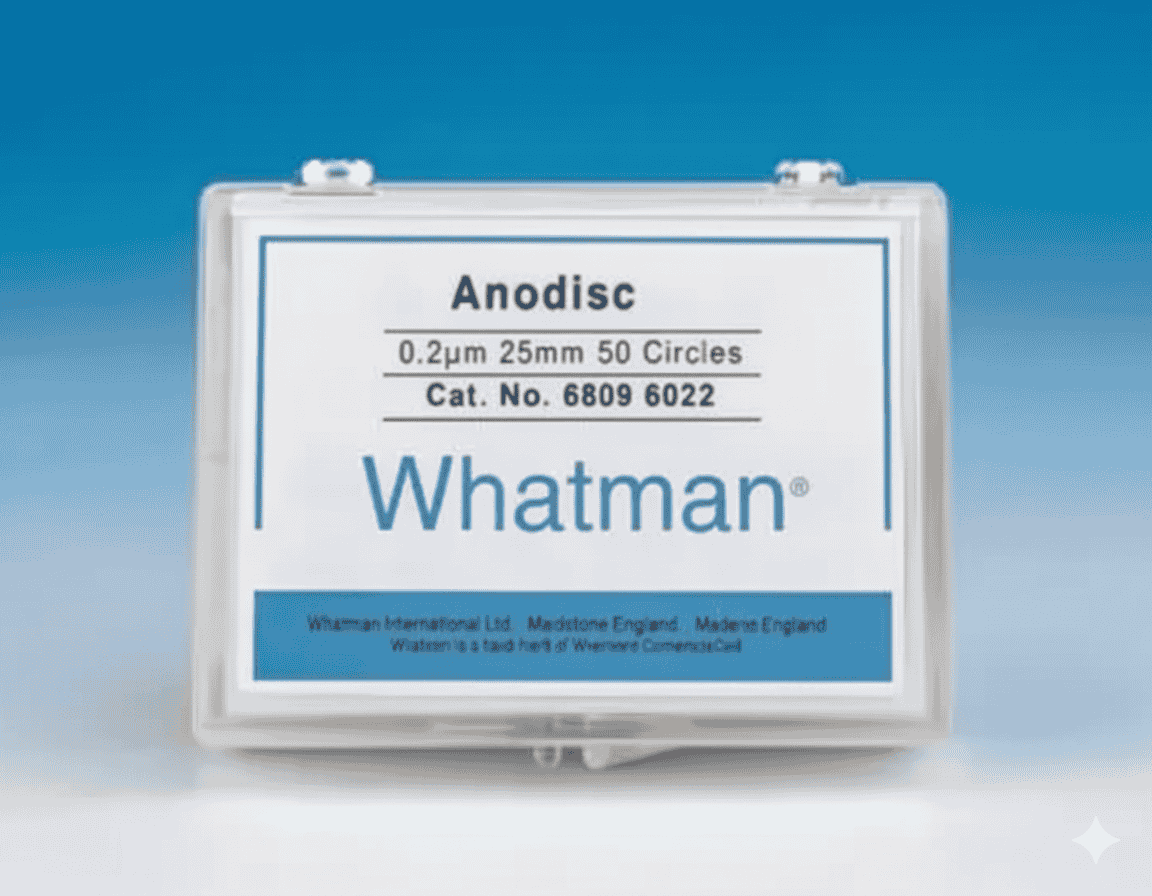

Whatman ANOD membrane filters deliver ultra-low protein binding and high chemical resistance. Ideal for sterile filtration, particle retention, and analytical clarity.
₹28,740.00 – ₹66,833.00Price range: ₹28,740.00 through ₹66,833.00
Product Name – Whatman ANOD Membrane Filter
Quantity/Pack Size – 13MM, 0.02um (Pack of 100), 13MM, 0.1um (Pack of 100), 13MM, 0.2um (Pack of 100), 25MM, 0.02um (Pack of 50), 25MM, 0.1um (Pack of 50), 25MM, 0.2um (Pack of 50), 47MM, 0.02um (Pack of 50), 47MM, 0.1um (Pack of 50), 47MM, 0.2um (Pack of 50)
Form – Membrane discs
Grade – Anodisc (Aluminum oxide)
Application – Sterile filtration, particle analysis, protein binding studies
Whatman ANOD membrane filters are engineered from high-purity anodic aluminum oxide, offering exceptional chemical resistance and ultra-low protein binding for critical laboratory applications. The uniform pore structure ensures precise particle retention, making them ideal for sterile filtration, analytical sample preparation, and high-resolution microscopy. Unlike organic membranes, ANOD filters withstand harsh solvents, acids, and bases without compromising integrity, ensuring reliable performance in demanding protocols. Their inert surface minimizes non-specific binding, preserving sample purity for accurate downstream analysis. Available in multiple pore sizes (0.02?m, 0.1?m, 0.2?m) and diameters (13MM, 25MM, 47MM), these filters adapt to diverse workflows, from microbial filtration to nanoparticle characterization. The rigid, non-deformable structure prevents swelling or shrinking, maintaining consistent flow rates and retention efficiency. Compatible with standard filtration apparatus, ANOD membranes integrate seamlessly into existing lab setups, reducing setup time and improving reproducibility. Their durability and reusability (with proper cleaning) offer cost-effective solutions for high-throughput labs, while the lot-to-lot consistency guarantees reproducible results across experiments.
These filters can withstand temperatures up to 400?C, making them suitable for autoclaving and high-temperature applications without structural degradation.
Yes, the aluminum oxide composition provides excellent compatibility with organic solvents, including DMSO, acetone, methanol, and most acids/bases, unlike cellulose or PES membranes.
Rinse with deionized water or mild detergent, followed by sonication in ethanol (if needed). Avoid abrasive cleaning tools to preserve the membrane?s pore structure. Dry thoroughly before reuse.
While primarily designed for liquid filtration, ANOD membranes can filter gases if properly housed in a compatible holder, though flow rates may vary based on pore size and pressure.
For hydrophobic applications, consider PTFE membranes, which repel water while allowing gas/air passage. ANOD filters are inherently hydrophilic due to their aluminum oxide composition.
| Size | 13MM-0.02uM (Pack of 100), 13MM-LF0.02uM (Pack of 100), 13MM-0.1uM (Pack of 100), 13MM-0.2uM (Pack of 100), 25MM-0.02uM (Pack of 50), 25MM-0.1uM (Pack of 50), 25MM-0.2uM (Pack of 50), 47MM-0.02uM (Pack of 50), 47MM-0.02uM (Pack of 50), 47MM-0.1uM (Pack of 50), 47MM-0.2uM (Pack of 50), 47MM-0.2uM (Pack of 50) |
|---|
High-purity Whatman Grade 1 Cellulose Filter Paper ensures consistent filtration performance and chemical resistance.
High-purity Whatman Grade 1 Cellulose Filter Paper ensures consistent filtration performance and chemical resistance.
High-purity Whatman Grade 1 Cellulose Filter Paper ensures consistent filtration performance and chemical resistance.
High-purity Whatman Grade 1 Cellulose Filter Paper ensures consistent filtration performance and chemical resistance.
High-purity Whatman Grade 1 Cellulose Filter Paper ensures consistent filtration performance and chemical resistance.

₹28,740.00 – ₹66,833.00Price range: ₹28,740.00 through ₹66,833.00
Whatman ANOD membrane filters deliver ultra-low protein binding and high chemical resistance. Ideal for sterile filtration, particle retention, and analytical clarity.
Product Name – Whatman ANOD Membrane Filter
Quantity/Pack Size – 13MM, 0.02um (Pack of 100), 13MM, 0.1um (Pack of 100), 13MM, 0.2um (Pack of 100), 25MM, 0.02um (Pack of 50), 25MM, 0.1um (Pack of 50), 25MM, 0.2um (Pack of 50), 47MM, 0.02um (Pack of 50), 47MM, 0.1um (Pack of 50), 47MM, 0.2um (Pack of 50)
Form – Membrane discs
Grade – Anodisc (Aluminum oxide)
Application – Sterile filtration, particle analysis, protein binding studies
Whatman ANOD membrane filters are engineered from high-purity anodic aluminum oxide, offering exceptional chemical resistance and ultra-low protein binding for critical laboratory applications. The uniform pore structure ensures precise particle retention, making them ideal for sterile filtration, analytical sample preparation, and high-resolution microscopy. Unlike organic membranes, ANOD filters withstand harsh solvents, acids, and bases without compromising integrity, ensuring reliable performance in demanding protocols. Their inert surface minimizes non-specific binding, preserving sample purity for accurate downstream analysis. Available in multiple pore sizes (0.02?m, 0.1?m, 0.2?m) and diameters (13MM, 25MM, 47MM), these filters adapt to diverse workflows, from microbial filtration to nanoparticle characterization. The rigid, non-deformable structure prevents swelling or shrinking, maintaining consistent flow rates and retention efficiency. Compatible with standard filtration apparatus, ANOD membranes integrate seamlessly into existing lab setups, reducing setup time and improving reproducibility. Their durability and reusability (with proper cleaning) offer cost-effective solutions for high-throughput labs, while the lot-to-lot consistency guarantees reproducible results across experiments.
These filters can withstand temperatures up to 400?C, making them suitable for autoclaving and high-temperature applications without structural degradation.
Yes, the aluminum oxide composition provides excellent compatibility with organic solvents, including DMSO, acetone, methanol, and most acids/bases, unlike cellulose or PES membranes.
Rinse with deionized water or mild detergent, followed by sonication in ethanol (if needed). Avoid abrasive cleaning tools to preserve the membrane?s pore structure. Dry thoroughly before reuse.
While primarily designed for liquid filtration, ANOD membranes can filter gases if properly housed in a compatible holder, though flow rates may vary based on pore size and pressure.
For hydrophobic applications, consider PTFE membranes, which repel water while allowing gas/air passage. ANOD filters are inherently hydrophilic due to their aluminum oxide composition.
| Size | 13MM-0.02uM (Pack of 100), 13MM-LF0.02uM (Pack of 100), 13MM-0.1uM (Pack of 100), 13MM-0.2uM (Pack of 100), 25MM-0.02uM (Pack of 50), 25MM-0.1uM (Pack of 50), 25MM-0.2uM (Pack of 50), 47MM-0.02uM (Pack of 50), 47MM-0.02uM (Pack of 50), 47MM-0.1uM (Pack of 50), 47MM-0.2uM (Pack of 50), 47MM-0.2uM (Pack of 50) |
|---|
High-purity Whatman Grade 1 Cellulose Filter Paper ensures consistent filtration performance and chemical resistance.
High-purity Whatman Grade 1 Cellulose Filter Paper ensures consistent filtration performance and chemical resistance.
High-purity Whatman Grade 1 Cellulose Filter Paper ensures consistent filtration performance and chemical resistance.
High-purity Whatman Grade 1 Cellulose Filter Paper ensures consistent filtration performance and chemical resistance.
High-purity Whatman Grade 1 Cellulose Filter Paper ensures consistent filtration performance and chemical resistance.
Agra | Firozabad | Hathras | Mathura | Vrindavan | Aligarh | Lucknow | Ambala | Mainpuri | Shikohabad | Alwar | Bhind | Bharatpur | Morena | Gwalior | Orai | Kanpur | Jhansi | Hardoi | Shahjahanpur | Lakhimpur | Pilibhit | Haldwani | Basti | Gorakhpur | Deoria | Azamgarh | Prayagraj | Varanasi | Sultanpur | Moradabad and more….

Not a member? Create an account
Already got an account? Sign in here
By Clicking “Download Now”, you are confirming that you have read and agree to eqipped.com ‘s Terms of Use and Privacy Policy.
By Clicking “Join Now”, you are confirming that you have read and agree to eqipped.com ‘s Terms of Use and Privacy Policy.